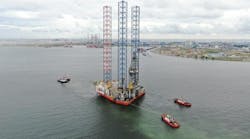Long-term contracts needed for imports
Jeremy Beckman
Editor
Europe
- GPLNG plans to pipe gas from a new LNG terminal at Pipavav 90 km under the Gulf of Khambat to Hazira. [28,748 bytes]
- Gas supply-demand outlook for India (source: GAIL). [6,370 bytes]
Following last year's nuclear tit for tat with Pakistan, the nation's image took a knock overseas. Subsequent sanctions by the US led to India's sovereign debt rating slumping below investment grade.
Although the sanctions have recently been lifted, the same system of coalition government remains that has stifled petroleum activity around the sub-continent previously. With international E&P budgets coincidentally constrained, it may take more than a licensing makeover to revive India's appeal.
Ultimately, the answer to India's worsening energy crisis may come from long-distance imports and LNG, rather than deepwater exploration. Government officials confirmed as much at SMi's recent Indian Oil & Gas Summit in London.
ONGC dominates
Bombay High in the mid-1980s remains India's last major oil find. Few foreign oil companies have drilled with conviction in other Indian basins since. As an illustration, 90% of the 181 exploration wells drilled around India in 1987 were operated by state oil company ONGC.A major disincentive for outsiders has been ONGC and IOC's monopoly on prime acreage. They also retain rights to some of the 48 new blocks on offer, but from now on will be directed by the government to seek joint venture bids with foreign companies to manage licences. This is a core initiative of the New Exploration Licensing Policy, known in short as NELP ("HELP" might have been more accurate, according to one Indian official in London). Other incentives under the new regime are:
- No signature discovery or production bonuses
- Seven-year income tax holiday
- 50% royalty rate for deepwater acreage (400 meters-plus) during the first seven years of commercial production
- Freedom to sell oil and gas to international as well as domestic markets
- Possibility of farm-ins.
In reaction to the proposals at the SMi conference, Bob Moore, International Legal Affairs Manager at UK independent Enterprise Oil, applauded the new fiscal stability provision, the removal of signature bonuses, and also of mandatory state participation.
"But there are other regimes that have these plus points," he said. He also argued that for all the new incentives, Indian bureacracy has not gone away. "There are too many consents required, which cause delays. PSC negotiations in India are still too slow - four years on average, I've heard. Life's too short, and at a company of Enterprise's size, we don't have the staff to negotiate at an oil price of $10-11/bbl."
Unocal Bharat President Arun Metre pre-empted this argument earlier, explaining that "those interested in participating in Indian fuel supply must change their normal business time-frame, and take a long-term view. The slow pace of reform in India is due to frequent changes in political leadership, as well as bureaucracy.
"On the other hand, the government needs to firm up a clear and comprehensive energy policy through establishing a single Ministry for Energy. There should be quicker execution of bids by NELP and that also applies to awards of PSCs and exploration licences. Taxation should be equalized for foreign and domestic participants, and there should be greater incentives for high-risk deepwater exploration and for marginal fields."
Gas shift
C.R.Prasad, Chairman of the Gas Authority of India (GAIL), highlighted the shifting energy mix in India. In 1987, gas consumption on the mainland was almost zero, with industry reliant on naphtha, oil, and coal. Now 23 bcm/yr is produced from Indian gasfields, mainly by ONGC and Oil & Gas India, but of late also from Cairn Energy's offshore Ravva Field.Prasad claimed that reserves of up to 700 bcm were there to be produced, including natural gas hydrates beneath the deep waters off the west and east coasts (according to geologists). These could be accessed using Gulf of Mexico-type drilling techniques and drillships, he said.
"Potentially, projected national demand of 143 MMcm/d in 1999-2000 could soar to 285 MMcm/d by 2009-10. Whenever we've put in a pipeline, industry has come forward for even more gas. The power industry, for instance, is going in leaps and bounds towards natural gas as a basic feedstock." Now the residential and commercial sectors are joining the gas rush, including some 5-star Indian hotels previously locked into LNG or fuel oils.
Barring major new hydrocarbon discoveries, this clamor may have to be satisfied by long-distance means. According to Uncoal's Metre, there is a case for a pipeline taking in supplies from Myanmar's fields in the Gulf of Martaban (suddenly surplus to requirements in Thailand) in a parabolic curve up through Bangladesh and into north-east India. The vastness of the Bay of Bengal would likely militate against a purely offshore route.
Other pipelines
Metre harked back to other long distance transmission projects such as the Iran-India pipeline. An MOU was signed between GAIL and the National Iranian Gas Company, but Pakistan's government vetoed a route through Pakistani waters. Hence, the project has lain dormant for the past two years.The deepwater Oman-India pipeline idea was abandoned by the Omani government, partly due to insufficient available gas volumes, but India's government still appears interested in the concept, Metre claimed.
A third project, currently under discussion, involves a network of pipelines carrying gas from Turkmenistan and Afghanistan to Pakistan, with a possible extension to India. In the way are perceptions of Afghan (in)stability and Indo-Pakistani cooperation talks. On the plus side, Metre argued, such a project would create a new Energy Corridor, in addition to jobs in associated industries.
For any of these projects to come off, however, India would have to address further its deregulation and taxation issues, he warned, if it wished to play a strategic role in development and transportation of gas in southern Asia.
LNG potential
India could also provide salvation to the LNG moguls, with markets in Japan, Taiwan and Korea still fading. India's economy is relatively sound compared with others in the region, with only a modest slowdown forecast for industrial growth to 4%. According to Prasad, Australia is interested in bringing LNG from its giant gasfields in the Timor Sea or off the North West Shelf. Iran, however, looks to be four years away from establishing an LNG industry, he suggested.Fourteen proposals have been issued for new LNG terminals around India, of which five to six are progressing, Prasad said. "So we can expect 20 million tons of LNG to be imported into India over the next 6-7 years."
But the major LNG supplier should be other countries in the Middle East. Qatar has abundant excess supplies from its offshore and onshore gasfields, which it aims to develop for the growing spot trade. Rasgas was recently selected to supply 7.5 metric tons/yr under a long-term contract to Petronet (a joint venture between GAIL and Indian oil companies) for a new terminal in Dahej on India's west coast.
BG India's CEO Gerard Rees foresaw government planning possibly confounded by a future supply shortfall of 46 MMcm/d, "so the potential for LNG could be even more significant." On the other hand, he countered, LNG trading in India "is significantly disadvantaged relative to other fuels by the fiscal regime, so some reform of the existing tax and duty structure will be needed if it is to be allowed to compete." As things stand, India today would charge an import duty of 28% on LNG, he said, compared with 5% maximum in all other LNG importing nations.
Studying other regimes
Prasad said that India's government was currently studying UK and US gas regulatory regimes to establish the best model. Metre claimed that pricing was critical. "A market-driven mechanism should be in place that allows India to reach parity with international gas prices by 2002."Another problem, said Rees, was that LNG contracts demand long-term commitments by both buyer and seller. This is contrary to the fuel contracts negotiated historically by industry in India. "We believe that a new mindset will be required by the customers so that they are prepared to lock into a given price formula with no chance to switch out at some time in the future." He went on "the minimum scale for an import terminal is about 2.5 million tons per annum, and this demand must be creditworthy."
Near Dahej is India's first private sector port in Pipavav on the Saurashtra coast. A joint venture between BG and Sea King Engineers - Gujarat Pipavav LNG Co (GPLNG) - is building an import terminal to receive LNG from Yemen. This will be piped across the Gulf of Khambat to Hazira and other towns to the north. The 90 km pipeline will be installed in water depths of up to 30 meters.
Initial throughput from terminal of 2.5 million tons/yr is expected to climb rapidly to 5 million tons/yr. In time, the partners hope to extend the pipeline network north to Ahmedabad and south to Maharashtra and Bombay, where BG also owns 50% of the gas distribution company.
Fortunately for the pipelay contractor, Pipavav is sheltered from monsoon waves by three offshore islands, so there is no need to build a breakwater to shelter vessels. This is not the case at the other terminals planned for Hazira and Dahej, where currents are more severe. Rees claimed that the extra costs incurred at these facilities would exceed the price of GPLNG's subsea pipeline. The venture already has a "no objection" certificate for the pipeline crossing. Target for first gas deliveries is end-2001.
Copyright 1999 Oil & Gas Journal. All Rights Reserved.




